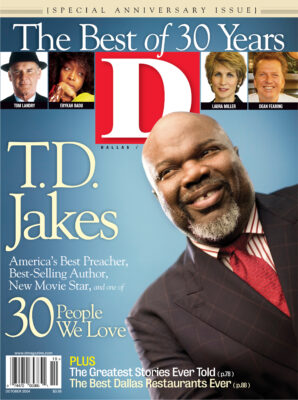When I returned to Dallas to resuscitate a floundering D Magazine nine years ago, several friends told me it couldn’t be done.
“The city has changed too much,” they said. “It can’t be captured in a magazine anymore.”
My answer was that a city may change, but a city’s culture never changes. San Francisco will always be San Francisco, Des Moines will always be Des Moines, and Dallas will always be Dallas. People and styles may change, but geography and history don’t, and they are the determinants of culture.
I was right, and I was wrong. Dallas had changed and, in most ways, for the better. The financial bust of the ’80s had been like a punch to the solar plexus—it had forcefully expelled a lot of hot air. The experience had humbled a city that had never been known for its modesty.
But it had also removed the city’s most cohesive force: its three independent banks. Our first cover story 30 years ago was titled “Power in Dallas: Who Holds the Cards?” The answer was easy. The banks held the cards, and we showed how the interlocking directorates of our major corporations connected with the banks that financed them.
All that vanished—almost overnight—20 years ago, and Dallas has been in recovery ever since. In a business town, the most noticeable change was the disappearance of the business leadership. Politics abhors a vacuum, so politicians happily tried to fill the void. They’re still trying.
But did the character of Dallas change? The other day, an interviewer asked me to say, in one word, what I liked most about Dallas. I said, “Ideas.” Dallas, unlike Atlanta or, say, Minneapolis, is an open city much like New York. It welcomes new arrivals. Unlike New York, it also welcomes new ideas. New York is the world’s financial center, and finance people distrust anything new. Dallas is an entrepreneurial center, and it embraces things that are new. Wildcatters 70 years ago made men millionaires. “Risk” isn’t a dirty word. New is good.
When I was a sophomore at UT Austin in 1968, the dean recommended me to a major corporation out of Milwaukee whose foundation wanted to launch a summer jobs program for minority teenagers in several cities, including Dallas. The first task, I was told, was to enlist community leaders. Not knowing any better, I picked up the phone and called John Stemmons. A week later, I found myself sitting at a lunch meeting while Mr. Stemmons handed out assignments: building owner, donate the space; Southwestern Bell, put in the phones; Mobil Oil, arrange transportation. Two months later, the jobs center opened, and 7,000 kids were given work at more than 200 companies.
The efficiency was Dallas in its heyday, but the openness to a new idea was the same one I found four years later when I began trudging up and down downtown streets seeking capital for a new magazine.
Dallas encourages ideas, and that is its most distinguishing characteristic. But the city doesn’t just encourage ideas, it feeds off them. That’s why I’ve enjoyed my second tenure at D Magazine as much as my first. We’re in the business of turning ideas into reality. That being our chosen craft, we couldn’t have invented a better place to practice it.
Related Articles

Local News
Wherein We Ask: WTF Is Going on With DCAD’s Property Valuations?
Property tax valuations have increased by hundreds of thousands for some Dallas homeowners, providing quite a shock. What's up with that?

Commercial Real Estate
Former Mayor Tom Leppert: Let’s Get Back on Track, Dallas
The city has an opportunity to lead the charge in becoming a more connected and efficient America, writes the former public official and construction company CEO.
By Tom Leppert

Things to Do in Dallas
Things To Do in Dallas This Weekend
How to enjoy local arts, music, culture, food, fitness, and more all week long in Dallas.
By Bethany Erickson and Zoe Roberts


